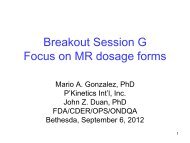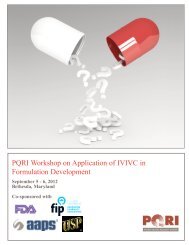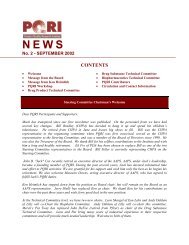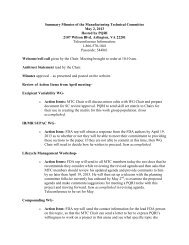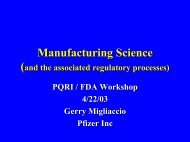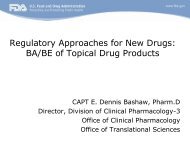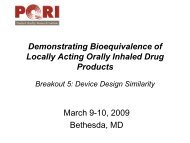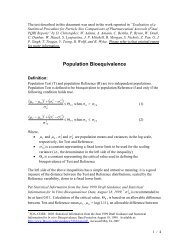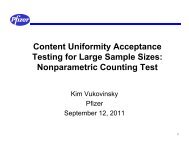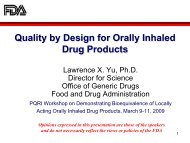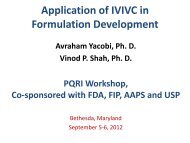PODP Approach to Acquire Extractable Profile Data - PQRI
PODP Approach to Acquire Extractable Profile Data - PQRI
PODP Approach to Acquire Extractable Profile Data - PQRI
Create successful ePaper yourself
Turn your PDF publications into a flip-book with our unique Google optimized e-Paper software.
<strong>PODP</strong> E&L<br />
Working Group<br />
<strong>PODP</strong> <strong>Approach</strong> <strong>to</strong> <strong>Acquire</strong><br />
<strong>Extractable</strong> <strong>Profile</strong> <strong>Data</strong><br />
Thomas Egert<br />
Alan Hendricker<br />
Chris Hous<strong>to</strong>n<br />
T. Egert, A. Hendricker,<br />
C. Hous<strong>to</strong>n<br />
Bethesda, February 2011<br />
Thresholds and Best Practices for<br />
Parenteral and Ophthalmic Drug<br />
Products (<strong>PODP</strong>)<br />
February 22-23, 2011
<strong>PODP</strong> E&L<br />
Working Group<br />
<strong>PODP</strong> <strong>Approach</strong> <strong>to</strong> <strong>Acquire</strong><br />
<strong>Extractable</strong> <strong>Profile</strong> <strong>Data</strong><br />
Part 1: The Experimental Pro<strong>to</strong>col<br />
Thomas Egert<br />
Research Scientist<br />
Boehringer Ingelheim Pharma GmbH & Co.KG<br />
T. Egert, A. Hendricker,<br />
C. Hous<strong>to</strong>n<br />
Bethesda, February 2011
<strong>PODP</strong> E&L<br />
Working Group<br />
<strong>PODP</strong><br />
Experimental<br />
Pro<strong>to</strong>col<br />
Summary of Results<br />
Recommended Best<br />
Practices for<br />
<strong>Extractable</strong>s Testing<br />
T. Egert, A. Hendricker,<br />
C. Hous<strong>to</strong>n<br />
Bethesda, February 2011<br />
<strong>PODP</strong> Working Plan Hypothesis<br />
• Threshold concepts that have been developed for safety<br />
qualification of leachables in OINDP can be extrapolated<br />
<strong>to</strong> the evaluation and safety qualification of leachables in<br />
<strong>PODP</strong>, with consideration of fac<strong>to</strong>rs and parameters such<br />
as dose, duration, patient population and additional<br />
product dependent characteristics unique <strong>to</strong> various <strong>PODP</strong><br />
types.<br />
• The “good science” best demonstrated practices that were<br />
established for the OINDP pharmaceutical development<br />
process can be extrapolated <strong>to</strong> container closure systems<br />
for <strong>PODP</strong>.<br />
• Threshold and best practices concepts can be integrated<br />
in<strong>to</strong> a comprehensive process for characterizing container<br />
closure systems with respect <strong>to</strong> leachable substances and<br />
their associated impact on <strong>PODP</strong> safety.<br />
3
<strong>PODP</strong> E&L<br />
Working Group<br />
<strong>PODP</strong><br />
Experimental<br />
Pro<strong>to</strong>col<br />
Summary of Results<br />
Work Plan Outline<br />
• “. . . In order <strong>to</strong> test the hypothesis that<br />
best demonstrated practices for the<br />
characterization and analytical evaluation<br />
(of <strong>PODP</strong>) exist, the Working Group must<br />
establish such practices …“<br />
Recommended Best<br />
Practices for<br />
<strong>Extractable</strong>s Testing<br />
Motivation for a Experimental<br />
Program (Phase I):<br />
T. Egert, A. Hendricker,<br />
C. Hous<strong>to</strong>n<br />
Bethesda, February 2011<br />
• Controlled Extraction<br />
Studies !<br />
4
<strong>PODP</strong> E&L<br />
Working Group<br />
Coming from OINDP Best Practices:<br />
Controlled Extraction Studies are the first<br />
experimental miles<strong>to</strong>ne . . .<br />
<strong>PODP</strong><br />
Experimental<br />
Pro<strong>to</strong>col<br />
Select components and/or raw<br />
materials<br />
Conduct rusk assessment on<br />
information from supplier<br />
Individual<br />
ingredient poses<br />
unacceptable<br />
risk<br />
YES<br />
• Safety Thresholds and<br />
Best Practices for<br />
<strong>Extractable</strong>s and<br />
Leachables in Orally<br />
Inhaled and Nasal Drug<br />
Products 2006<br />
Summary of Results<br />
NO<br />
Conduct controlled extraction<br />
studies on components<br />
Individual<br />
extractable greater<br />
than or equal <strong>to</strong> the<br />
AET/SCT<br />
Recommended Best<br />
Practices for<br />
<strong>Extractable</strong>s Testing<br />
Develop and validate<br />
extraction studies on<br />
components<br />
NO<br />
No further safety assessment<br />
NO<br />
YES<br />
Conduct leachables studies on<br />
drug product and placebo<br />
Individual<br />
extractable greater<br />
than or equal <strong>to</strong> the<br />
AET/SCT<br />
Establish correlation between<br />
leachables and extractables<br />
profiles<br />
YES<br />
Report leachable <strong>to</strong><br />
<strong>to</strong>xicologist for risk<br />
assessment<br />
Report extractable <strong>to</strong><br />
<strong>to</strong>xicologist for risk<br />
assessment<br />
T. Egert, A. Hendricker,<br />
C. Hous<strong>to</strong>n<br />
Bethesda, February 2011<br />
Establish acceptance criteria<br />
for leachables and extractables<br />
Go <strong>to</strong> safety qualification<br />
process<br />
5
<strong>PODP</strong> E&L<br />
Working Group<br />
<strong>PODP</strong><br />
Experimental<br />
Pro<strong>to</strong>col<br />
Summary of Results<br />
Recommended Best<br />
Practices for<br />
<strong>Extractable</strong>s Testing<br />
Recapitulation:<br />
What is the Purpose of a Controlled<br />
Extraction Study<br />
• Verify and complement supplier information about<br />
material<br />
• Establish a basis for the development and<br />
validation of routine quality control methods and<br />
acceptance criteria for critical components<br />
extractables profiles (consistency in composition)<br />
• Establish a basis for the development and<br />
validation of leachables methods<br />
• Allow for correlation of extractables and leachables<br />
T. Egert, A. Hendricker,<br />
C. Hous<strong>to</strong>n<br />
Bethesda, February 2011<br />
6
<strong>PODP</strong> E&L<br />
Working Group<br />
Investigation of Workplan Hypothesis<br />
Implies <strong>to</strong> Investigate:<br />
<strong>PODP</strong><br />
Experimental<br />
Pro<strong>to</strong>col<br />
Summary of Results<br />
• Nature of typical <strong>PODP</strong> materials and their<br />
(unique?) interactions with typical <strong>PODP</strong> drug<br />
product formulations (implications for<br />
extraction solvents and – techniques)<br />
• Universe of substances encountered<br />
Recommended Best<br />
Practices for<br />
<strong>Extractable</strong>s Testing<br />
• Applicability of AET – related concept (OINDPparadigm)<br />
<strong>to</strong> extraction studies on <strong>PODP</strong><br />
materials<br />
T. Egert, A. Hendricker,<br />
C. Hous<strong>to</strong>n<br />
Bethesda, February 2011<br />
7
<strong>PODP</strong> E&L<br />
Working Group<br />
Investigation of Workplan Hypothesis<br />
Implies <strong>to</strong> Investigate (cont‘d):<br />
Analytical methods:<br />
<strong>PODP</strong><br />
Experimental<br />
Pro<strong>to</strong>col<br />
Summary of Results<br />
Recommended Best<br />
Practices for<br />
<strong>Extractable</strong>s Testing<br />
• Appropriate range of instrumental techniques<br />
(Likelihood of comprehensive evaluation of<br />
extractables)<br />
• Identification performance, suitable <strong>to</strong> generate<br />
data for safety assessment based on:<br />
(i) SAR endpoints<br />
(ii) confirmed identification<br />
T. Egert, A. Hendricker,<br />
C. Hous<strong>to</strong>n<br />
Bethesda, February 2011<br />
• Sensitivity (in terms of lowest level for<br />
identification)<br />
• Specificity (matrix interferences)<br />
• Limitations (critical substances/mixtures)?<br />
8
<strong>PODP</strong> E&L<br />
Working Group<br />
<strong>PQRI</strong> <strong>PODP</strong> Experimental Pro<strong>to</strong>col<br />
The General Concept<br />
<strong>PODP</strong><br />
Experimental<br />
Pro<strong>to</strong>col<br />
Summary of Results<br />
Recommended Best<br />
Practices for<br />
<strong>Extractable</strong>s Testing<br />
T. Egert, A. Hendricker,<br />
C. Hous<strong>to</strong>n<br />
Bethesda, February 2011<br />
• Test Articles representing <strong>PODP</strong> materials<br />
• Appropriate extraction techniques<br />
• Appropriate solvents<br />
• Various analytical techniques<br />
• Various participating labora<strong>to</strong>ries<br />
(experienced in the field of E&L)<br />
• Comprehensive and detailed experimental<br />
pro<strong>to</strong>col<br />
• Semiquantitative approach –<br />
Reporting Limit 10 µg/g<br />
• Quality requirements (system suitability)<br />
9
<strong>PODP</strong> E&L Test Articles<br />
Working Group<br />
(Material Type)<br />
Test Articles Representing <strong>PODP</strong> Materials<br />
Format<br />
Composition<br />
(Supplier Information)<br />
Application<br />
Category<br />
Polycarbonate<br />
(PC)<br />
Injection<br />
moulded<br />
plaques<br />
• 0.05 PHR Irganox 1076<br />
• 0.1 PHR Irgafos 168<br />
Ports,<br />
Tubes<br />
LVP<br />
Rubber<br />
Elas<strong>to</strong>mer<br />
(Bromobutyl)<br />
Sheet • Brominated isobutylene isoprene<br />
copolymer (57.3%)<br />
• calcined aluminum silicate, 38.2%<br />
• titanium dioxide, 1.2%;<br />
• paraffinic oil, 1.2%;<br />
• zinc oxide, 0.6%<br />
• polyethylene0.6%<br />
• SRF Carbon block mixture, 0.4%<br />
• calcined magnesium oxide, 0.3%<br />
• 4,4’-dithiodimorpholine/polyisobutylene,<br />
0.3%<br />
Closures,<br />
Plungers,<br />
Gaskets<br />
SVP<br />
Cyclic Olefin<br />
Copolymer<br />
(COC)<br />
Plaques • Irganox 1010<br />
• Ultramarine Blue<br />
Syringes,<br />
Vials<br />
PFS, SVP<br />
Polyvinylchloride<br />
(PVC)<br />
Pellets • PVC resin<br />
• DEHP 30%<br />
• Epoxidized oil 7%<br />
• Zn stearate 0.5%<br />
• Ca stearate 0.5%<br />
• Stearamide 1%<br />
Bags,<br />
Tubing<br />
LVP<br />
T. Egert, A. Hendricker,<br />
C. Hous<strong>to</strong>n<br />
Bethesda, February 2011<br />
Low density<br />
polyethylene<br />
(LDPE)<br />
Blown Film<br />
• Irganox B 215 (2:1 blend of Irgafos<br />
168 and Irganox 1010) 1000 ppm<br />
• BHT 200 ppm<br />
• Calcium Stearate 500 ppm<br />
• Erucamide 500 ppm<br />
• Chimassorb 944 2000 ppm<br />
Overpouch,<br />
BFS,<br />
Containers<br />
BFS, SVP,<br />
LVP<br />
10
<strong>PODP</strong> E&L<br />
Working Group<br />
<strong>PODP</strong><br />
Experimental<br />
Pro<strong>to</strong>col<br />
Solvents should mimic drug product<br />
formulation<br />
• The majority of <strong>PODP</strong> are represented by aqueous based<br />
formulations !<br />
• Cosolvents can be subdivided in<strong>to</strong> two groups:<br />
A: Polarity Neutral<br />
B: Polarity Impacting<br />
Summary of Results<br />
Primary function of excipient is not drug<br />
solubilization<br />
Generally compounds with high<br />
aqueous solubility:<br />
Components primary function is <strong>to</strong><br />
increase the solubility of the drug<br />
Recommended Best<br />
Practices for<br />
<strong>Extractable</strong>s Testing<br />
• Diluents (dextrose, saline)<br />
• Buffers (acetate, lactate, bicarbonate,<br />
phosphate)<br />
• Amino acids<br />
• Vitamins<br />
• Tween 80<br />
• Cyclodextrins<br />
• SDS<br />
• Lipids up <strong>to</strong> 20% wt/wt<br />
• Surfactants, Emollients<br />
T. Egert, A. Hendricker,<br />
C. Hous<strong>to</strong>n<br />
Bethesda, February 2011<br />
Aqueous pH 2.5 / 9.5<br />
Isopropanol / Water<br />
11
<strong>PODP</strong> E&L<br />
Working Group<br />
Extraction/Solvent Map<br />
Solvent Polarity /<br />
Drug Product Similarity<br />
Temp.<br />
Thermal<br />
n‐ Isopropanool/Water<br />
pH 2.5 pH 9.5<br />
Isopropan‐<br />
Aqueous Aqueous<br />
Hexane<br />
Headspace X ‐‐‐ ‐‐‐ ‐‐‐ ‐‐‐ ‐‐‐<br />
Reflux ‐‐‐ X X PC/PVC only ‐‐‐ ‐‐‐<br />
Soxhlet ‐‐‐ X X ‐‐‐ ‐‐‐ ‐‐<br />
Sealed Vessel ‐‐‐ ‐‐‐ ‐‐‐ 55°C/3d<br />
(121°C/<br />
1hr) 1<br />
Sonication ‐‐‐ ‐‐‐ ‐‐‐ ‐‐‐ x x<br />
1 : au<strong>to</strong>clave conditions: (121°C/1hr)<br />
(121°C/<br />
1hr) 1<br />
T. Egert, A. Hendricker,<br />
C. Hous<strong>to</strong>n<br />
Bethesda, February 2011<br />
12
<strong>PODP</strong> E&L<br />
Working Group<br />
Extraction “Paradigms*” in Labora<strong>to</strong>ry Practice<br />
• Vigorous/exaggerated/-<br />
exhaustive conditions<br />
• no material deformulation<br />
‣„Hot“ extraction techniques<br />
but no sample dissolving<br />
solvents<br />
• Solvents should be<br />
attributed <strong>to</strong> the<br />
expected universe of<br />
substances (cover<br />
wide range of polarity)<br />
• Solvents<br />
should mimic<br />
drug product<br />
formulation<br />
Thermal<br />
n‐ Isopropanool/Water<br />
pH 2.5 pH 9.5<br />
Isopropan‐<br />
Aqueous Aqueous<br />
Hexane<br />
Headspace X ‐‐‐ ‐‐‐ ‐‐‐ ‐‐‐ ‐‐‐<br />
Reflux ‐‐‐ X X PC/PVC only ‐‐‐ ‐‐‐<br />
Soxhlet ‐‐‐ X X ‐‐‐ ‐‐‐ ‐‐<br />
Sealed Vessel ‐‐‐ ‐‐‐ ‐‐‐ 55°C/3d<br />
(121°C/<br />
1hr) 1<br />
Sonication ‐‐‐ ‐‐‐ ‐‐‐ ‐‐‐ x x<br />
1 : au<strong>to</strong>clave conditions: (121°C/1hr)<br />
(121°C/<br />
1hr) 1<br />
T. Egert, A. Hendricker,<br />
C. Hous<strong>to</strong>n<br />
Bethesda, February 2011<br />
13
<strong>PODP</strong> E&L<br />
Working Group<br />
Analytical Methods – General Aspects<br />
Primary Focus:<br />
• Specific analytical procedures<br />
<strong>PODP</strong><br />
Experimental<br />
Pro<strong>to</strong>col<br />
(non specific could have supplemental character (e.g.<br />
gravimetry, pho<strong>to</strong>metry, <strong>to</strong>tal organic carbon, alkalinity, acidity,<br />
reducing subtances, infrared, thermal gravimetry etc.) <br />
pharmacopoeial testing<br />
Summary of Results<br />
Recommended Best<br />
Practices for<br />
<strong>Extractable</strong>s Testing<br />
T. Egert, A. Hendricker,<br />
C. Hous<strong>to</strong>n<br />
Bethesda, February 2011<br />
•Non-Target Analysis in addition <strong>to</strong> targets known from<br />
composition<br />
•“Small“ molecules (< 1000 Da)<br />
•Trace (Organic) Analysis<br />
•Standard – chroma<strong>to</strong>graphic conditions suitable <strong>to</strong><br />
efficiently separate the majority of the log Po/w range <strong>to</strong><br />
be expected.<br />
•What you might been missing . . .?<br />
14
<strong>PODP</strong> E&L<br />
Working Group<br />
Analytical Methods<br />
…choosing the most adequate <strong>to</strong>ols …<br />
<strong>PODP</strong><br />
Experimental<br />
Pro<strong>to</strong>col<br />
Summary of Results<br />
Recommended Best<br />
Practices for<br />
<strong>Extractable</strong>s Testing<br />
Inorganic<br />
Trace elements and metals<br />
ICP/MS<br />
Organic<br />
Volatiles substances:<br />
Static Headspace-GC/MS<br />
Semivolatiles (GC-amenable)<br />
GC/MS<br />
Semivolatiles (not GC-amenable)<br />
LC/UV<br />
LC/MS n , HRMS<br />
T. Egert, A. Hendricker,<br />
C. Hous<strong>to</strong>n<br />
Bethesda, February 2011<br />
Philosophy:<br />
Identification <strong>to</strong> an extent practicable . . .<br />
(OINDP Best Practices)<br />
15
Conditions<br />
for Analytical<br />
<strong>PODP</strong> E&L<br />
Working Group<br />
Methods<br />
(Chroma<strong>to</strong>graphy)<br />
Headspace-GC/MS<br />
Column:<br />
DB WAXETR<br />
60 m x iD 0.32 mm, FT 1.0 µm<br />
He 5 psi<br />
GC/FID (MS)<br />
Column:<br />
DB 5HT<br />
30m x 0.25 mm, FT 0.25µm<br />
LC/UV (MS)<br />
Column:<br />
Agilent Zorbax Exclipse Plus<br />
C18, 100 x 3.0 mm,<br />
3.5 µm particles<br />
Oven-Program<br />
35°C-7 min-1 K/min - 40°C – 15 min -<br />
10 K/min – 100 - 25 K/min – 240 - 5 min<br />
MS: EI 70 eV, 25 – 200 amu<br />
Headspace-Cond.: 80°C - 120 min<br />
Oven-Program<br />
50°C – 5 min – 10 K/min – 330°C – 5min<br />
Inj.-Vol. 1 µl, splitless<br />
Injec<strong>to</strong>r: 310 °C<br />
FID: 150°C<br />
MS: EI 70 eV, 33-650 amu<br />
Mobile-Phase<br />
A : 10 mM ammonium acetate<br />
B : ace<strong>to</strong>nitrile<br />
Flow rate: 0.8 mL/min<br />
T. Egert, A. Hendricker,<br />
C. Hous<strong>to</strong>n<br />
Bethesda, February 2011<br />
Column Oven : 40 °C<br />
Gradient:<br />
Sample Size: 10 µl Time: %B<br />
0.0 5.0<br />
Detection 8.4 100.0<br />
UV 205 - 300 nm 35.0 100.0<br />
MS API-ES positive and 36.0 5.0<br />
negative ion (mass 39.0 5.0<br />
range 80 - 1200)<br />
16
<strong>PODP</strong> E&L<br />
Working Group<br />
Identification <strong>to</strong> “the Extent Practicable”…<br />
Identification attributes according <strong>to</strong> OINDP Best Practices<br />
have been applied<br />
Category<br />
Supporting Identification <strong>Data</strong><br />
<strong>PODP</strong><br />
Experimental<br />
Pro<strong>to</strong>col<br />
A<br />
B<br />
Mass spectrometric fragmentation behaviour<br />
Confirmation of molecular weight<br />
C<br />
Confirmation of elemental composition<br />
Summary of Results<br />
D<br />
Mass spectrum matches au<strong>to</strong>mated library or<br />
literature spectrum<br />
Recommended Best<br />
Practices for<br />
<strong>Extractable</strong>s Testing<br />
T. Egert, A. Hendricker,<br />
C. Hous<strong>to</strong>n<br />
Bethesda, February 2011<br />
E<br />
Confimed<br />
Confident<br />
Tentative<br />
Mass spectrum and chroma<strong>to</strong>graphic retention<br />
index match authentic specimen<br />
Categories A, B(or)C and D(or)E fulfilled<br />
Sufficient <strong>Data</strong> <strong>to</strong> preclude all but the most<br />
closely related structures have been obtained<br />
<strong>Data</strong> have obtained that are consistent with a<br />
class of molecule only<br />
Confir<br />
med ID<br />
SAR<br />
Endpoints<br />
17
<strong>PODP</strong> E&L<br />
Working Group<br />
System Suitability Requirements were<br />
applied <strong>to</strong> moni<strong>to</strong>r result integrity<br />
Level 1 - Qualified Instrumentation<br />
<strong>PODP</strong><br />
Experimental<br />
Pro<strong>to</strong>col<br />
Summary of Results<br />
Recommended Best<br />
Practices for<br />
<strong>Extractable</strong>s Testing<br />
T. Egert, A. Hendricker,<br />
C. Hous<strong>to</strong>n<br />
Bethesda, February 2011<br />
•Proper instrument condition and instrument suitabilty will be demonstrated<br />
by each participating labora<strong>to</strong>ry by following its proprietay (inhouse)<br />
procedures<br />
Level 2 – System suitability mixtures<br />
•Specific test mixtures <strong>to</strong> be analyzed by HS-GC, GC, LC and ICP<br />
•Test mixtures are suitable <strong>to</strong> demonstrate adequate and effective analytical<br />
performance (separation efficiency, selectivity, sensitivity)<br />
•Results be evaluated against defined acceptance criteria<br />
Level 3 - Internal standardization<br />
•Surrogate Internal Standard – added <strong>to</strong> the extract<br />
control of effectiveness of the sample preparation process<br />
•Injection Internal Standard – added <strong>to</strong> the injection solution<br />
control of the sample introduction and chroma<strong>to</strong>graphic process for each<br />
sample run.<br />
18
<strong>PODP</strong> E&L<br />
Working Group<br />
Suitability Mixtures HS-GC and GC<br />
HS-<br />
GC Cus<strong>to</strong>m-Mix: (µg/vial)<br />
<strong>PODP</strong><br />
Experimental<br />
Pro<strong>to</strong>col<br />
methanol 2<br />
acetic acid 2<br />
cyclohexanone 1<br />
<strong>to</strong>luene 1<br />
trimethylsilanol 2<br />
2-ethyl hexanol 2<br />
dance<br />
2e+07<br />
1.9e+07<br />
1.8e+07<br />
1.7e+07<br />
1.6e+07<br />
1.5e+07<br />
1.4e+07<br />
1.3e+07<br />
1.2e+07<br />
1.1e+07<br />
1e+07<br />
9000000<br />
8000000<br />
7000000<br />
6000000<br />
5000000<br />
4000000<br />
3000000<br />
2000000<br />
1000000<br />
16.608<br />
TIC: 9NOV2009003.D\ data.ms<br />
33.201<br />
32.014<br />
31.309<br />
39.182<br />
37.957<br />
39.064<br />
Summary of Results<br />
GC “Grob”-Mix: (µg/ml)<br />
><br />
10.00 15.00 20.00 25.00 30.00 35.00 40.00<br />
Recommended Best<br />
Practices for<br />
<strong>Extractable</strong>s Testing<br />
L(+)-2,3-butanediol 27<br />
n-decane 14<br />
2,6-dimethylaniline 16<br />
2,6-dimethylphenol 16<br />
methyl decanoate (C10:0) 21<br />
methyl docecanoate (C12:0) 21<br />
methyl undecanoate (C11:0) 21<br />
nonanal 20<br />
1-octanal 18<br />
n-undecane (C11) 14<br />
1300000<br />
1200000<br />
1100000<br />
1000000<br />
900000<br />
800000<br />
700000<br />
600000<br />
500000<br />
400000<br />
300000<br />
1<br />
200000<br />
100000<br />
Time--><br />
2<br />
Signal: 1201014.D\FID1A.CH<br />
6<br />
7<br />
5<br />
9<br />
11<br />
3<br />
8<br />
12<br />
10<br />
4<br />
Grob Mix (1/100)<br />
8 9 10 11 12 13 14 15<br />
T. Egert, A. Hendricker,<br />
C. Hous<strong>to</strong>n<br />
Bethesda, February 2011<br />
19
<strong>PODP</strong> E&L<br />
Working Group<br />
Suitability Mixtures LC and ICP<br />
LC<br />
(UV/MS) Cus<strong>to</strong>m-Mix: (µg/ml)<br />
<strong>PODP</strong><br />
Experimental<br />
Pro<strong>to</strong>col<br />
Summary of Results<br />
caprolactam 1<br />
butylatedhydroxy<strong>to</strong>luene 5<br />
diphenylamine 5<br />
mono-(2-ethylhexyl)<br />
1<br />
phthalate<br />
stearic acid 5<br />
di-(2-ethylhexyl phthalate) 1<br />
bisphenol A 1<br />
DAD1 A, Sig=210,20 Ref =360,100 (JIJ2009\JI000003.D)<br />
mAU<br />
-500<br />
0 2 4 6 8 10 12 14 16<br />
MSD1 TIC, MS File (JIJ2009\JI000003.D) API-ES, Neg, Scan, Frag: 100, "Negativ e"<br />
50000<br />
0 2 4 6 8 10 12 14 16<br />
MSD2 TIC, MS File (JIJ2009\JI000003.D) API-ES, Pos, Scan, Frag: 100, "Positiv e"<br />
200000<br />
0<br />
0 2 4 6 8 10 12 14 16<br />
MSD2 114, EIC=113.7:114.7 (JIJ2009\JI000003.D) API-ES, Pos, Scan, Frag: 100, "Positiv e"<br />
min<br />
min<br />
min<br />
0<br />
0 2 4 6 8 10 12 14 16<br />
MSD1 227, EIC=226.7:227.7 (JIJ2009\JI000003.D) API-ES, Neg, Scan, Frag: 100, "Negativ e"<br />
min<br />
Recommended Best<br />
Practices for<br />
<strong>Extractable</strong>s Testing<br />
0<br />
0 2 4 6 8 10 12 14 16<br />
MSD1 277, EIC=276.7:277.7 (JIJ2009\JI000003.D) API-ES, Neg, Scan, Frag: 100, "Negativ e"<br />
0<br />
0 2 4 6 8 10 12 14 16<br />
MSD1 299, EIC=298.7:299.7 (JIJ2009\JI000003.D) API-ES, Neg, Scan, Frag: 100, "Negativ e"<br />
min<br />
min<br />
20000<br />
0<br />
0 2 4 6 8 10 12 14 16<br />
MSD1 283, EIC=282.7:283.7 (JIJ2009\JI000003.D) API-ES, Neg, Scan, Frag: 100, "Negativ e"<br />
min<br />
20000<br />
0<br />
0 2 4 6 8 10 12 14 16<br />
MSD2 391, EIC=390.7:391.7 (JIJ2009\JI000003.D) API-ES, Pos, Scan, Frag: 100, "Positiv e"<br />
min<br />
T. Egert, A. Hendricker,<br />
C. Hous<strong>to</strong>n<br />
Bethesda, February 2011<br />
ICP all target elements 0.25<br />
100000<br />
0<br />
0 2 4 6 8 10 12 14 16<br />
20<br />
min
<strong>PODP</strong> E&L<br />
Working Group<br />
Surrogate Internal Standard<br />
Internal Standards<br />
Objective Requirements Substance used<br />
<strong>PODP</strong><br />
Experimental<br />
Pro<strong>to</strong>col<br />
Moni<strong>to</strong>ring of<br />
sample<br />
preparation<br />
process and<br />
instrumental<br />
performance<br />
• sufficiently stable<br />
• sufficiently soluble in all extraction<br />
solvents<br />
• amenable <strong>to</strong> back-extraction from<br />
aqueous extracts by organic solvents<br />
• amenable <strong>to</strong> TMS-derivatization<br />
• semi-volatile<br />
• amenable <strong>to</strong> all detection principles<br />
• selectively detectable<br />
Bisphenol M<br />
CAS 13595-25-0<br />
MW: 346.46<br />
Summary of Results<br />
Injection Internal Standard<br />
Objective Requirements Substance used<br />
Recommended Best<br />
Practices for<br />
<strong>Extractable</strong>s Testing<br />
Moni<strong>to</strong>ring of<br />
instrumental<br />
performance<br />
• sufficiently stable<br />
• sufficiently soluble in final extract<br />
• semi-volatile<br />
• amenable <strong>to</strong> all detection principles<br />
• selectively detectable<br />
Irganox 415<br />
CAS: 96-69-5<br />
MW: 358.538<br />
T. Egert, A. Hendricker,<br />
C. Hous<strong>to</strong>n<br />
Bethesda, February 2011<br />
Headspace Internal Standard<br />
1,4-Dioxane<br />
CAS: 123-91-1<br />
MW: 88.11<br />
21
Experimental<br />
Workflow<br />
<strong>PODP</strong> E&L<br />
Working Group<br />
T. Egert, A. Hendricker,<br />
C. Hous<strong>to</strong>n<br />
Bethesda, February 2011<br />
22
Experimental<br />
<strong>PODP</strong> Workflow E&L<br />
Working Group<br />
Phase 1/3: Extract Preparation<br />
Thermal<br />
n‐ Isopropanool/Water<br />
pH 2.5 pH 9.5<br />
Isopropan‐<br />
Aqueous Aqueous<br />
Hexane<br />
Headspace X ‐‐‐ ‐‐‐ ‐‐‐ ‐‐‐ ‐‐‐<br />
Reflux ‐‐‐ X X PC/PVC only ‐‐‐ ‐‐‐<br />
Soxhlet ‐‐‐ X X ‐‐‐ ‐‐‐ ‐‐<br />
Sealed Vessel ‐‐‐ ‐‐‐ ‐‐‐ 55°C/3d<br />
(121°C/<br />
1hr) 2<br />
(121°C/<br />
1hr) 2<br />
Sonication ‐‐‐ ‐‐‐ ‐‐‐ ‐‐‐ x x<br />
1 : All test articles (materials) were extracted following this scheme if not indicated otherwise<br />
2 : au<strong>to</strong>clave conditions: (121°C/1hr)<br />
Extraction Techniques:<br />
Soxhlet (min. 10 cycles, 24 hrs, 5 g- 200 ml)<br />
Reflux (2 hrs, 5 g - 200 ml)<br />
Sonication (2 hrs, T=0°C, 5 g - 200 ml)<br />
Sealed Vessel (55 °C / 3 d, 5 g- 200 ml)<br />
Sealed Vessel Au<strong>to</strong>claved<br />
(121 °C / 1 hr 5 g - 200 ml, 2 replicates)<br />
Test Articles:<br />
Sample Weight [5g]<br />
Sample Pre-treatment<br />
Materials:<br />
LDPE<br />
PC<br />
PVC<br />
COC<br />
Rubber<br />
HS-GC/MS(FID)<br />
ICP/MS(AES)<br />
Aqueous Extract<br />
pH 2.5<br />
200 ml<br />
Aqueous Extract<br />
pH 9.5<br />
200 ml<br />
IPA/Water extract<br />
200 ml<br />
IPA extract<br />
200 ml<br />
N-Hexane extract<br />
200 ml<br />
T. Egert, A. Hendricker,<br />
C. Hous<strong>to</strong>n<br />
Bethesda, February 2011<br />
23
Experimental<br />
<strong>PODP</strong> Workflow E&L<br />
Working Group<br />
Phase 2/3: Sample Preparation<br />
T. Egert, A. Hendricker,<br />
C. Hous<strong>to</strong>n<br />
Bethesda, February 2011<br />
24
Experimental<br />
<strong>PODP</strong> Workflow E&L<br />
Working Group<br />
Phase 3/3: Instrumental Analysis<br />
T. Egert, A. Hendricker,<br />
C. Hous<strong>to</strong>n<br />
Bethesda, February 2011<br />
25
<strong>PODP</strong> E&L<br />
Working Group<br />
Challenges Ahead:<br />
What could have been missed?<br />
Example: Epoxidized soybean oil (specif. PVC stabilizer):<br />
<strong>PODP</strong><br />
Experimental<br />
Pro<strong>to</strong>col<br />
Mixture of glycerol esters –<br />
75 possible structures<br />
consisting of: (~ %)<br />
Epoxidized trilinolein<br />
C 57 H 98 O 12, MW 975.45 g/mol<br />
O<br />
Palmitic acid C16:0 11<br />
O<br />
Summary of Results<br />
Stearic acid C18:0 5<br />
Recommended Best<br />
Practices for<br />
<strong>Extractable</strong>s Testing<br />
Epoxidized oleic acid C18:1 8<br />
Epoxidized linoleic acid C18:2 23<br />
Epoxidized linolenic acid C18:3 54<br />
O<br />
O<br />
O<br />
O<br />
O<br />
O<br />
O<br />
O<br />
O<br />
O<br />
T. Egert, A. Hendricker,<br />
C. Hous<strong>to</strong>n<br />
Bethesda, February 2011<br />
• Identified and quantified ?<br />
• Almost missed ?<br />
• Completely missed ?<br />
26
<strong>PODP</strong> E&L<br />
Working Group<br />
<strong>PODP</strong> <strong>Approach</strong> <strong>to</strong> <strong>Acquire</strong><br />
<strong>Extractable</strong> <strong>Profile</strong> <strong>Data</strong><br />
Part 2: Summary of Results<br />
Alan Hendricker<br />
Catalent Pharma Solutions<br />
Thresholds and Best Practices for<br />
Parenteral and Ophthalmic Drug<br />
Products (<strong>PODP</strong>)<br />
February 22-23, 2011<br />
T. Egert, A. Hendricker,<br />
C. Hous<strong>to</strong>n<br />
Bethesda, February 2011
<strong>PODP</strong> E&L<br />
Working Group<br />
<strong>PODP</strong><br />
Experimental Pro<strong>to</strong>col<br />
Summary of Results<br />
Recommended Best<br />
Practices for<br />
<strong>Extractable</strong>s Testing<br />
T. Egert, A. Hendricker,<br />
C. Hous<strong>to</strong>n<br />
Bethesda, February 2011<br />
Test Articles for <strong>Extractable</strong>s Studies<br />
Material Type<br />
Low density polyethylene<br />
(LDPE)<br />
Material<br />
Application<br />
Test Articles.<br />
Material<br />
Format<br />
Composition<br />
Overpouch Blown Film Dow 640-I LDPE resin;<br />
Irganox B 215 (2:1 blend of<br />
Irgafos 168 and Irganox 1010)<br />
1000 ppm, BHT 200 ppm,<br />
Calcium Stearate 500 ppm,<br />
Erucamide 500 ppm,<br />
Chimassorb 944 2000 ppm<br />
Cyclic Olefin (COC) Syringe barrels, vials Plaques Irganox 1010, Ultramarine<br />
Blue<br />
Polycarbonate (PC) Port Tubes Injection<br />
molded plaques<br />
Poly (vinyl chloride)<br />
(PVC)<br />
Rubber (Elas<strong>to</strong>mer) (RE)<br />
Solution Bags,<br />
tubing<br />
Gaskets, s<strong>to</strong>ppers,<br />
closures<br />
0.05 Parts per Hundred (PHR)<br />
Irganox 1076, 0.1 PHR<br />
Irgafos 168<br />
Pellets PVC resin; DEHP 30%;<br />
Epoxidized oil 7%, Zn<br />
stearate 0.5%; Ca stearate<br />
0.5%; Stearamide 1%<br />
Sheets<br />
Brominated isobutylene isoprene<br />
copolymer (57.3%); calcined<br />
aluminum silicate, 38.2%, titanium<br />
dioxide, 1.2%; paraffinic oil, 1.2%;<br />
zinc oxide, 0.6%; polyethylene,<br />
0.6%; SRF Carbon block mixture,<br />
0.4%; calcined magnesium oxide,<br />
0.3%; 4,4’-dithiodimorpholine/polyisobutylene,<br />
0.3%
<strong>PODP</strong> E&L<br />
Working Group<br />
Poly(vinyl chloride) PVC Test Material<br />
Metals Results all less than 5 µg/g. Calcium and Zinc<br />
(known additives) detected in most extracts. Maximum<br />
Calcium 1.72 µg/g, Zinc 1.33 µg/g<br />
<strong>PODP</strong><br />
Experimental Pro<strong>to</strong>col<br />
Summary of Results<br />
Recommended Best<br />
Practices for<br />
<strong>Extractable</strong>s Testing<br />
Volatiles testing (HS-GC-MS) showed primarily aliphatic<br />
hydrocarbons of short chain length, branched and<br />
unbranched. One volatile identified was attributed <strong>to</strong> 2-ethyl-<br />
1-hexanol, a known extractable from PVC.<br />
Semivolatiles testing (GC-MS) showed a large number of<br />
peaks (up <strong>to</strong> 50) for each extraction condition. Peaks were<br />
attributed <strong>to</strong> fatty acids, fatty amides, fatty alcohols, fatty<br />
acid esters, fatty aldehydes, aliphatic hydrocarbons, BHT,<br />
phthalates, phthalate esters and phthalate degradation<br />
products. Fatty acids and related peaks were observed at<br />
the highest concentrations (up <strong>to</strong> around 500 ppm).<br />
Non-volatiles testing (LC-MS) confirmed GC-MS results,<br />
peaks detected were attributed <strong>to</strong> fatty acids, fatty amides<br />
(erucamide, (z)-9-Octadecenamide), and phthalates.<br />
Example of a PVC<br />
IV Bag<br />
T. Egert, A. Hendricker,<br />
C. Hous<strong>to</strong>n<br />
Bethesda, February 2011<br />
29
<strong>PODP</strong> E&L<br />
Working Group<br />
Polycarbonate (PC) Test Material<br />
Metals results showed only trace level metals except in one<br />
extraction condition (Au<strong>to</strong>clave/pH 2.5) which showed<br />
approximately 50 µg/g of Zn and 25 µg/g of Ca.<br />
<strong>PODP</strong><br />
Experimental Pro<strong>to</strong>col<br />
Volatiles testing using HS-GC-MS showed only low levels of a few<br />
volatiles with a maximum concentration of 0.12 µg/g for nonanal.<br />
Ace<strong>to</strong>ne and ace<strong>to</strong>nitrile were also observed at trace levels.<br />
Summary of Results<br />
Recommended Best<br />
Practices for<br />
<strong>Extractable</strong>s Testing<br />
T. Egert, A. Hendricker,<br />
C. Hous<strong>to</strong>n<br />
Bethesda, February 2011<br />
Semivolatiles testing of extracts using GC-MS showed a<br />
significant number of peaks, including several phenolic peaks<br />
which are likely degradation products of the polymer itself. Most<br />
notable of these was Bisphenol-A, a compound of significant<br />
potential <strong>to</strong>xicity. It is not known the extent <strong>to</strong> which this species<br />
is generated via the extraction versus being present at<br />
endogenous levels. Other species detected included Irgafos 168<br />
and its oxidation product, Irganox 1076, 2,4-di-t-butylphenol and<br />
dimethyphthalate.<br />
Non-volatiles testing (LC-MS) showed a significant number of<br />
peaks, many of which overlapped and for which first pass<br />
identification was not possible. They may be various oligomeric<br />
fragments related <strong>to</strong> the base polymer.<br />
Example of a<br />
Polycarbonate<br />
Baby Bottle (no<br />
longer marketed)<br />
30
<strong>PODP</strong> E&L<br />
Working Group<br />
<strong>PODP</strong><br />
Experimental Pro<strong>to</strong>col<br />
Cyclic Olefin Copolymer (COC) Test<br />
Material<br />
Metals results showed only trace levels of metals in general.<br />
One extraction condition (Au<strong>to</strong>clave/pH 2.5) showed<br />
approximately 25 µg/g of Mg 44 µg/g of Zn and 68 µg/g of<br />
Bromine.<br />
Volatiles testing using HS-GC-MS showed very clean<br />
profiles, only one peak attributed <strong>to</strong> Cis-decahydronaphthalene<br />
was observed at 0.03 µg/g.<br />
Summary of Results<br />
Recommended Best<br />
Practices for<br />
<strong>Extractable</strong>s Testing<br />
Semivolatiles testing of extracts using GC-MS showed a<br />
large number of peaks, especially via sealed vessel<br />
extraction. Peaks detected were attributed <strong>to</strong> fatty acids,<br />
fatty acid esters, siloxanes, phthalate related peaks and a<br />
significant number of peaks which could not be given first<br />
pass identifications. The intensity of peaks observed in all<br />
extracts was very small, typically less than 0.1 µg/g. With<br />
several extraction technique, no discernable extractables<br />
could be detected using this method.<br />
COC Syringe<br />
T. Egert, A. Hendricker,<br />
C. Hous<strong>to</strong>n<br />
Bethesda, February 2011<br />
Non-volatiles testing (LC-MS) showed no peaks in sealed<br />
vessel or sonication extractions. Reflux extraction in IPA<br />
produced several low level peaks which could not be<br />
identified (less than approximately 0.1 µg/g).<br />
31
<strong>PODP</strong> E&L<br />
Working Group<br />
<strong>PODP</strong><br />
Experimental Pro<strong>to</strong>col<br />
Summary of Results<br />
Low density polyethylene (LDPE)<br />
Test Material<br />
Metals testing results showed no significant metal<br />
extractables (all less than 1 µg/g). Calcium (known<br />
additive) was not detected under any extraction<br />
condition.<br />
Volatiles testing using HS-GC-MS showed only one peak<br />
above the AET, which was late eluting and could not be<br />
identified. It was present at 0.26 µg/g.<br />
Recommended Best<br />
Practices for<br />
<strong>Extractable</strong>s Testing<br />
Semivolatiles testing of extracts using GC-MS showed<br />
BHT (antioxidant), Z-9-octadecenamide (antistatic)<br />
erucamide (antistatic) and Dilauryl-3,3'-thiodipropionate<br />
or Irganox PS 800 (heat stabilizer and antioxidant). A<br />
number of aliphatic hydrocarbons branched and<br />
unbranched can be observed, oligomeric fragments of<br />
the PE itself.<br />
Polyethylene<br />
resin beads<br />
T. Egert, A. Hendricker,<br />
C. Hous<strong>to</strong>n<br />
Bethesda, February 2011<br />
Non-volatiles testing (LC-MS) showed no additional<br />
identifiable extractables for the tests performed, though<br />
several peaks were observed at 220nm.<br />
32
<strong>PODP</strong> E&L<br />
Working Group<br />
<strong>PODP</strong><br />
Experimental Pro<strong>to</strong>col<br />
Rubber Elas<strong>to</strong>mer (RE) Test Material<br />
Metals results showed significant amounts of Bromine, up <strong>to</strong> 20<br />
µg/g, which was not surprising, since it was a bromobutyl<br />
elas<strong>to</strong>mer. Smaller amounts (all less than 10 µg/g) were detected<br />
of the other known metal additives, including Mg, Al, Ca, Ti and<br />
Zn. The pH 2.5 sonication extraction showed the highest levels of<br />
these metal species.<br />
Summary of Results<br />
Recommended Best<br />
Practices for<br />
<strong>Extractable</strong>s Testing<br />
Volatiles testing using HS-GC-MS showed several peaks<br />
attributed <strong>to</strong> butyl oligomers. Peaks attributed <strong>to</strong> methyl<br />
cyclopentane and cyclohexane were also observed. All peaks<br />
except cyclohexane were less than 1 µg/g, except<br />
methylcyclopentane at 1.19 µg/g.<br />
Semivolatiles testing of extracts using GC-MS showed an<br />
extremely complex extractables profile, with large numbers of<br />
unknowns. Peaks identified were attributed <strong>to</strong> fatty acids, fatty<br />
acid esters, fatty amides, aliphatic hydrocarbon species, BHT, and<br />
brominated oligomers.<br />
Example of<br />
Elas<strong>to</strong>meric<br />
S<strong>to</strong>ppers<br />
T. Egert, A. Hendricker,<br />
C. Hous<strong>to</strong>n<br />
Bethesda, February 2011<br />
Non-volatiles testing (LC-MS) showed a complex unresolved<br />
envelope of dozens of peaks, especially for organic extracts. The<br />
method utilized was insufficient for peak identifications in most<br />
cases.<br />
33
<strong>PODP</strong> E&L<br />
Working Group<br />
Observations<br />
<strong>PODP</strong><br />
Experimental Pro<strong>to</strong>col<br />
• <strong>Profile</strong>s can be complex! With<br />
multiple extraction solvents and<br />
techniques hundreds of peaks can be<br />
extracted using the chroma<strong>to</strong>graphic<br />
methods<br />
Summary of Results<br />
• AET should be employed <strong>to</strong> help<br />
simplify data analysis<br />
Recommended Best<br />
Practices for<br />
<strong>Extractable</strong>s Testing<br />
T. Egert, A. Hendricker,<br />
C. Hous<strong>to</strong>n<br />
Bethesda, February 2011<br />
• In general, residual solvents and<br />
metals testing showed low levels of<br />
extractables and were generally<br />
innocuous species, but provided<br />
valuable information<br />
See the forest<br />
through the<br />
trees?<br />
34
<strong>PODP</strong> E&L<br />
Working Group<br />
Observations<br />
<strong>PODP</strong><br />
Experimental Pro<strong>to</strong>col<br />
Summary of Results<br />
Recommended Best<br />
Practices for<br />
<strong>Extractable</strong>s Testing<br />
T. Egert, A. Hendricker,<br />
C. Hous<strong>to</strong>n<br />
Bethesda, February 2011<br />
• Understand that the peaks you are<br />
detecting are not necessarily what was<br />
added <strong>to</strong> the polymer originally (e.g. 2,4-<br />
di-t-butylphenol and palmitic acid can<br />
originate from Irgafos 168 and Calcium<br />
Stearate, among others)<br />
• Use “realistic” extraction solvents <strong>to</strong><br />
understand risk. Use aggressive solvents<br />
<strong>to</strong> facilitate identifications<br />
• Oligomeric fragments represent<br />
challenging species for complete<br />
structural identification. However,<br />
compound class may be enough <strong>to</strong><br />
assess <strong>to</strong>xicological risk<br />
Abundance<br />
Time<br />
55000<br />
50000<br />
45000<br />
40000<br />
35000<br />
30000<br />
25000<br />
20000<br />
15000<br />
Time--><br />
Response_<br />
1300000<br />
1200000<br />
1100000<br />
1000000<br />
900000<br />
800000<br />
700000 x<br />
600000<br />
500000<br />
400000<br />
300000<br />
x<br />
1<br />
1<br />
3<br />
Signal: RS015.D\FID1A.CH<br />
Signal: RS020.D\FID1A.CH (*)<br />
Signal: RS021.D\FID1A.CH (*)<br />
Underivatized PVC pH9.5 Samples Overlay<br />
A - Internal Standard 1 (Irganox 415)<br />
27<br />
B - Internal Standard 2 (Bisphenol M)<br />
9<br />
13<br />
14<br />
22<br />
18 21<br />
19 23<br />
25<br />
6 8 10 12 14 16 18 20 22 24 26<br />
UNDERIVATIZED RUBBER ELASTOMER SAMPLES OVERLAY<br />
Signal: RS006.D\FID1A.CH<br />
Signal: RS017.D\FID1A.CH (*)<br />
Signal: RS027.D\FID1A.CH (*)<br />
x - Peaks with this symbol are similar in size, Extract vs Extraction blank<br />
x<br />
x<br />
x<br />
2<br />
3<br />
4<br />
5<br />
8<br />
9<br />
11<br />
10<br />
10<br />
11<br />
11<br />
14<br />
16<br />
15<br />
18<br />
17<br />
200000 1<br />
x<br />
18<br />
RE-pH2.5-1<br />
100000<br />
6 8 10 12 14 16 18 20 22 24 26<br />
16<br />
Do you see the<br />
trees now?<br />
20<br />
20<br />
21<br />
21<br />
30<br />
24<br />
25<br />
32<br />
26<br />
28<br />
26<br />
28<br />
29<br />
32<br />
36<br />
30<br />
ISTD1<br />
38<br />
A<br />
ISTD2<br />
B<br />
RE-IW-2<br />
RE-pH9.5-2<br />
35<br />
PVC-pH9.5-2<br />
PVC-pH9.5-1<br />
pH9.5-Blank-2
<strong>PODP</strong> E&L<br />
Working Group<br />
Observations<br />
• Solvents pH may change extractables<br />
(specific example shown subsequently)<br />
DAD1 A, Sig=220,4 Ref=550,50 (F:\3\500_B...SETS\50_RESULTS_MATERIALS\03_RE\LC-UV\013-1101_REF3_NHEX_RE.D)<br />
mAU<br />
400<br />
300<br />
200<br />
7 . 5 5 3 7 . 7 5 2<br />
8 . 6 6 0<br />
1 0 . 1 4 9<br />
<strong>PODP</strong><br />
Experimental Pro<strong>to</strong>col<br />
Summary of Results<br />
• Use HPLC-MS <strong>to</strong> complement GC-MS. As<br />
a standalone technique data interpretation in<br />
LC-MS can be difficult<br />
100<br />
0<br />
-100<br />
DAD1 A, Sig=220,4 Ref=550,50 (F:\3\500_B...SETS\50_RESULTS_MATERIALS\03_RE\LC-UV\013-1101_REF3_NHEX_RE.D)<br />
mAU<br />
400<br />
300<br />
200<br />
100<br />
9 . 2 6 7<br />
1 0 . 4 4 3<br />
1 0 . 8 9 9<br />
1 1 . 8 2 7<br />
.1 2 4<br />
1 2 . 4 4 7<br />
1 2 . 7 5 5<br />
1 3 . 23 17 80<br />
1 3 .9 2 6<br />
1 4 . 4 7 2<br />
2.5 5 7.5 10 12.5 15 17.5 20 22.5<br />
1 5 . 5 0 2<br />
1 6 . 6 1 7<br />
1 7 . 9 2 1<br />
min<br />
0<br />
Recommended Best<br />
Practices for<br />
<strong>Extractable</strong>s Testing<br />
• In some cases we did not observe known<br />
additives. Understand you may need <strong>to</strong> alter<br />
extraction conditions in some cases <strong>to</strong><br />
facilitate extraction. Or realize that you may<br />
never see them even through due diligence<br />
(e.g. consumed processing agent)<br />
-100<br />
5 10 15 20<br />
min<br />
T. Egert, A. Hendricker,<br />
C. Hous<strong>to</strong>n<br />
Bethesda, February 2011<br />
Where did my<br />
trees (peaks) go?<br />
36
<strong>PODP</strong> E&L<br />
Working Group<br />
<strong>PODP</strong><br />
Experimental Pro<strong>to</strong>col<br />
Observations<br />
How low could we go?<br />
• By applying state-of-the-art analytical procedures and<br />
instrumentation, the limits of identification for single chemical<br />
entities (extractables) observed were in the<br />
range of 0.1 – 100 µg/g of material…<br />
Summary of Results<br />
Recommended Best<br />
Practices for<br />
<strong>Extractable</strong>s Testing<br />
Phthalic<br />
anhydride<br />
3 µg/g<br />
T. Egert, A. Hendricker,<br />
C. Hous<strong>to</strong>n<br />
Bethesda, February 2011<br />
GC/MS – Chroma<strong>to</strong>gram: Isopropanol (Reflux) extract of PVC<br />
37
<strong>PODP</strong> E&L<br />
Working Group<br />
<strong>PODP</strong><br />
Experimental Pro<strong>to</strong>col<br />
Observations (and Last Tree Analogy)<br />
In the end, materials extractables characterization can produce a complex<br />
scene, difficult <strong>to</strong> interpret or understand but full of information and when<br />
done correctly, paints a great picture. See the posters for the full picture<br />
(warning: not quite as nice as the one below).<br />
Summary of Results<br />
Recommended Best<br />
Practices for<br />
<strong>Extractable</strong>s Testing<br />
T. Egert, A. Hendricker,<br />
C. Hous<strong>to</strong>n<br />
Bethesda, February 2011<br />
Maroon Bells, Aspen Colorado<br />
38
<strong>PODP</strong> E&L<br />
Working Group<br />
<strong>PODP</strong><br />
Experimental Pro<strong>to</strong>col<br />
Summary of Results<br />
Recommended<br />
Best Practices for<br />
<strong>Extractable</strong>s Testing<br />
T. Egert, A. Hendricker,<br />
C. Hous<strong>to</strong>n<br />
Bethesda, February 2011<br />
<strong>PODP</strong> <strong>Approach</strong> <strong>to</strong> <strong>Acquire</strong><br />
<strong>Extractable</strong> <strong>Profile</strong> <strong>Data</strong><br />
Part 3: Recommended Best<br />
Practices for <strong>Extractable</strong>s Testing<br />
Chris<strong>to</strong>pher T Hous<strong>to</strong>n<br />
Principal Scientist, Bausch + Lomb<br />
Thresholds and Best Practices for<br />
Parenteral and Ophthalmic Drug<br />
Products (<strong>PODP</strong>)<br />
February 22-23, 2011
<strong>PODP</strong> E&L<br />
Working Group<br />
Best Practices<br />
<strong>PODP</strong><br />
Experimental Pro<strong>to</strong>col<br />
Summary of Results<br />
Recommended<br />
Best Practices for<br />
<strong>Extractable</strong>s Testing<br />
• In September 2006, <strong>PQRI</strong> issued prior<br />
guidance for OINDP:<br />
• “Safety Thresholds and Best Practices for<br />
<strong>Extractable</strong>s and Leachables in Orally Inhaled and<br />
Nasal Drug Products”<br />
• Contained 10 best practices with respect <strong>to</strong><br />
controlled extraction studies<br />
• Most of these are quite relevant <strong>to</strong> <strong>PODP</strong><br />
• <strong>PODP</strong> nuances result from aqueous drug product<br />
formulations<br />
T. Egert, A. Hendricker,<br />
C. Hous<strong>to</strong>n<br />
Bethesda, February 2011<br />
40
<strong>PODP</strong> E&L<br />
Working Group<br />
<strong>PODP</strong><br />
Experimental Pro<strong>to</strong>col<br />
Summary of Results<br />
Recommended<br />
Best Practices for<br />
<strong>Extractable</strong>s Testing<br />
T. Egert, A. Hendricker,<br />
C. Hous<strong>to</strong>n<br />
Bethesda, February 2011<br />
Review of OINDP Best Practice<br />
Recommendations<br />
1. Controlled Extraction Studies should employ vigorous extraction with multiple<br />
solvents of varying polarity<br />
2. Controlled Extraction Studies should incorporate multiple extraction techniques<br />
3. Controlled Extraction Studies should include careful sample preparation based on<br />
knowledge of analytical techniques <strong>to</strong> be used<br />
4. Controlled Extraction Studies should employ multiple analytical techniques<br />
5. Controlled Extraction Studies should include a defined and systematic process for<br />
identification of individual extractables<br />
6. Controlled Extraction Study “definitive” extraction techniques/methods should be<br />
optimized<br />
7. During the Controlled Extraction Study process, sponsors should revisit supplier<br />
information describing component formulation<br />
8. Controlled Extraction Studies should be guided by an Analytical Evaluation<br />
Threshold (AET) that is based on an accepted safety evaluation threshold<br />
9. Polyaromatic hydrocarbons, N-nitrosamines, and 2-mercap<strong>to</strong>benzothiazole (MBT) are<br />
considered <strong>to</strong> be “special case” compounds, requiring evaluation by specific<br />
analytical techniques and technology defined threshold<br />
10. Qualitative and quantitative extractables profiles should be discussed with and<br />
reviewed by pharmaceutical development team <strong>to</strong>xicologists so that any potential<br />
safety concerns regarding individual extractables, i.e. potential leachables, are<br />
identified early in the pharmaceutical development process<br />
41
<strong>PODP</strong> E&L<br />
Working Group<br />
<strong>PODP</strong><br />
Experimental Pro<strong>to</strong>col<br />
Summary of Results<br />
Recommended<br />
Best Practices for<br />
<strong>Extractable</strong>s Testing<br />
“Controlled Extraction Studies should<br />
employ vigorous extraction with multiple<br />
solvents of varying polarity”<br />
• Prior OINDP recommendation:<br />
• Advocated use of water in extraction studies for<br />
aqueous products<br />
• Discouraged using water as the sole extraction<br />
solvent for components from aqueous drug products<br />
• <strong>PODP</strong> Experience:<br />
• Aligned with prior recommendation (Examples 1 - 3)<br />
• Relevance of pH (Examples 4 and 5)<br />
T. Egert, A. Hendricker,<br />
C. Hous<strong>to</strong>n<br />
Bethesda, February 2011<br />
42
<strong>PODP</strong> E&L<br />
Working Group<br />
Example 1:<br />
LDPE / Aqueous Drug Product<br />
<strong>PODP</strong><br />
Experimental Pro<strong>to</strong>col<br />
Summary of Results<br />
Recommended<br />
Best Practices for<br />
<strong>Extractable</strong>s Testing<br />
• In <strong>PODP</strong> pro<strong>to</strong>col, extracted LDPE with known<br />
additive package by multiple solvents /<br />
techniques including water<br />
• In ophthalmology, significant prior art for<br />
extractables used water as the only solvent<br />
• Although aqueous solvent extracts may be<br />
useful for gauging significant extractables, they<br />
may not promote understanding of the material<br />
T. Egert, A. Hendricker,<br />
C. Hous<strong>to</strong>n<br />
Bethesda, February 2011<br />
43
<strong>PODP</strong> E&L<br />
Working Group<br />
Example 1:<br />
LDPE / Aqueous Drug Product<br />
<strong>PODP</strong><br />
Experimental Pro<strong>to</strong>col<br />
Known<br />
Additive<br />
Sonication<br />
pH 2.5<br />
Sonication<br />
pH 9.5<br />
Sealed<br />
Vessel<br />
IPA/Water<br />
Irganox 1010<br />
Summary of Results<br />
Irgafos 168<br />
Recommended<br />
Best Practices for<br />
<strong>Extractable</strong>s Testing<br />
T. Egert, A. Hendricker,<br />
C. Hous<strong>to</strong>n<br />
Bethesda, February 2011<br />
BHT<br />
Ca Stearate<br />
(as stearic acid)<br />
Erucamide<br />
Red = Not detected / Green = detected by GC and/or HPLC 44
<strong>PODP</strong> E&L<br />
Working Group<br />
Example 1:<br />
LDPE / Aqueous Drug Product<br />
<strong>PODP</strong><br />
Experimental Pro<strong>to</strong>col<br />
Summary of Results<br />
Recommended<br />
Best Practices for<br />
<strong>Extractable</strong>s Testing<br />
• Sonication in aqueous solvents successfully detects<br />
erucamide, but no other anticipated additive<br />
• Solvents of different polarity provide better<br />
understanding of the material<br />
• Relevant <strong>to</strong> an aqueous product?<br />
• An aqueous extraction profile lacking extractables does<br />
not necessarily impart material knowledge<br />
• Though non-polar additives such as Irganox 1010 are less<br />
likely <strong>to</strong> migrate in<strong>to</strong> aqueous product, its identification<br />
alerts the researcher <strong>to</strong> look for more polar degradation /<br />
transformation products<br />
T. Egert, A. Hendricker,<br />
C. Hous<strong>to</strong>n<br />
Bethesda, February 2011<br />
45
<strong>PODP</strong> E&L<br />
Working Group<br />
Example 2:<br />
Extraction of DEHP from PVC<br />
<strong>PODP</strong><br />
Experimental Pro<strong>to</strong>col<br />
• PVC material contained 30% bis(2-ethylhexyl)<br />
phthalate (DEHP)<br />
• Sealed vessel extracts:<br />
DEHP<br />
Summary of Results<br />
Recommended<br />
Best Practices for<br />
<strong>Extractable</strong>s Testing<br />
IPA/Water<br />
pH 9.5<br />
pH 2.5<br />
T. Egert, A. Hendricker,<br />
C. Hous<strong>to</strong>n<br />
Bethesda, February 2011<br />
46
<strong>PODP</strong> E&L<br />
Working Group<br />
<strong>PODP</strong><br />
Experimental Pro<strong>to</strong>col<br />
Summary of Results<br />
Recommended<br />
Best Practices for<br />
<strong>Extractable</strong>s Testing<br />
Example 2:<br />
Extraction of DEHP from PVC<br />
• DEHP is a significant extractable from PVC<br />
• Aqueous (pH 2.5, 9.5) solvent detect<br />
significantly less DEHP than IPA/water<br />
• Many “aqueous” formulations are not purely<br />
aqueous, but contain surfactants or other<br />
excipients that enhance solubility<br />
• Using water as the only extraction solvent runs<br />
the risk of not observing a key extractable that<br />
is poorly water soluble but nonetheless<br />
soluble in drug product<br />
T. Egert, A. Hendricker,<br />
C. Hous<strong>to</strong>n<br />
Bethesda, February 2011<br />
47
<strong>PODP</strong> E&L<br />
Working Group<br />
Example 3:<br />
Solvent Polarity and Polycarbonate<br />
<strong>PODP</strong><br />
Experimental Pro<strong>to</strong>col<br />
Summary of Results<br />
• The strongest solvent does not always yield<br />
the worst-case extraction profile<br />
• Consider this example of isopropanol and n-<br />
hexane extracts generated by Soxhlet and<br />
reflux<br />
Recommended<br />
Best Practices for<br />
<strong>Extractable</strong>s Testing<br />
T. Egert, A. Hendricker,<br />
C. Hous<strong>to</strong>n<br />
Bethesda, February 2011<br />
48
<strong>PODP</strong> E&L<br />
Working Group<br />
Example 3:<br />
Solvent Polarity and Polycarbonate<br />
<strong>PODP</strong><br />
Experimental Pro<strong>to</strong>col<br />
Summary of Results<br />
Recommended<br />
Best Practices for<br />
<strong>Extractable</strong>s Testing<br />
<strong>Extractable</strong><br />
IPA<br />
Reflux<br />
Estimated Quantity (μg/g)<br />
IPA<br />
Soxhlet<br />
Hexane<br />
Reflux<br />
Hexane<br />
Soxhlet<br />
4-t-butylphenol 65.7 13.7 2.2 2.9<br />
2,4-di-t-butylphenol 56.0 24.3 2.0 29.4<br />
Bisphenol A 77.1 9.4 9.4 12.7<br />
Irgafos 168 35.9 13.6 0.3 0.8<br />
Irgafos 168, oxidized 25.1 17.2 0.0 1.6<br />
Irganox 1076 21.8 8.3 0.1 0.5<br />
T. Egert, A. Hendricker,<br />
C. Hous<strong>to</strong>n<br />
Bethesda, February 2011<br />
IPA is a superior solvent for many of these<br />
extractables, despite being “weaker”<br />
49
<strong>PODP</strong> E&L<br />
Working Group<br />
Example 4:<br />
pH Effects and Polycarbonate<br />
<strong>PODP</strong><br />
Experimental Pro<strong>to</strong>col<br />
• Polycarbonate extraction at pH 2.5 and 9.5<br />
BPA<br />
Summary of Results<br />
IPA/<br />
Water<br />
Recommended<br />
Best Practices for<br />
<strong>Extractable</strong>s Testing<br />
pH 9.5<br />
pH 2.5<br />
T. Egert, A. Hendricker,<br />
C. Hous<strong>to</strong>n<br />
Bethesda, February 2011<br />
50
<strong>PODP</strong> E&L<br />
Working Group<br />
Example 4:<br />
pH Effects and Polycarbonate<br />
<strong>PODP</strong><br />
Experimental Pro<strong>to</strong>col<br />
Summary of Results<br />
Recommended<br />
Best Practices for<br />
<strong>Extractable</strong>s Testing<br />
• Bisphenol A detected from polycarbonate<br />
• pH 2.5: 0.12 mg/L<br />
• pH 9.5: 1.7 mg/L<br />
• Not detected in isopropanol/water extract<br />
• At alkaline pH, an order of magnitude more<br />
BPA is observed than at acidic pH<br />
• Implications for product pH and packaging<br />
compatibility<br />
T. Egert, A. Hendricker,<br />
C. Hous<strong>to</strong>n<br />
Bethesda, February 2011<br />
51
<strong>PODP</strong> E&L<br />
Working Group<br />
<strong>PODP</strong><br />
Experimental Pro<strong>to</strong>col<br />
Summary of Results<br />
Recommended<br />
Best Practices for<br />
<strong>Extractable</strong>s Testing<br />
Example 5:<br />
pH and Solvent Effects / PVC<br />
• Diethylhexyl phthalate (DEHP) and monoethylhexyl<br />
phthalate (MEHP) detected<br />
• HPLC semiquantitative results:<br />
<strong>Extractable</strong> pH 2.5<br />
(mg/L)<br />
pH 9.5<br />
(mg/L)<br />
IPA/water<br />
(mg/L)<br />
DEHP 0.05 0.79 930<br />
MEHP 0.02 0.57 0.09<br />
T. Egert, A. Hendricker,<br />
C. Hous<strong>to</strong>n<br />
Bethesda, February 2011<br />
• DEHP and MEHP are extracted in significantly<br />
higher quantities at basic versus acidic pH<br />
• No single solvent system is sufficient for all analytes<br />
52
<strong>PODP</strong> E&L<br />
Working Group<br />
<strong>PODP</strong><br />
Experimental Pro<strong>to</strong>col<br />
Summary of Results<br />
Recommended<br />
Best Practices for<br />
<strong>Extractable</strong>s Testing<br />
T. Egert, A. Hendricker,<br />
C. Hous<strong>to</strong>n<br />
Bethesda, February 2011<br />
“Controlled Extraction Studies<br />
should incorporate multiple<br />
extraction techniques”<br />
• Prior OINDP recommendations:<br />
• Justification needed for low temperature techniques<br />
such as sonication with respect <strong>to</strong> extraction efficiency<br />
• Sonication found <strong>to</strong> be less efficient than Soxhlet<br />
and reflux by OINDP working group<br />
• Extraction profiles from higher temperature extraction<br />
techniques should be carefully examined for extraction<br />
artifacts.<br />
• <strong>PODP</strong> Experience<br />
• Aqueous extraction by sonication versus sealed vessel<br />
(Example 6)<br />
• Thermal methods, headspace GC (Example 7)<br />
53
<strong>PODP</strong> E&L<br />
Working Group<br />
Example 6:<br />
Sonication v. Sealed Vessel / Polycarbonate<br />
<strong>PODP</strong><br />
Experimental Pro<strong>to</strong>col<br />
Summary of Results<br />
Recommended<br />
Best Practices for<br />
<strong>Extractable</strong>s Testing<br />
• Sealed vessel (121 °C, 1 hr) at pH 2.5 or 9.5<br />
• Bisphenol A detected<br />
• 0.12 mg/L @ pH 2.5<br />
• 1.7 mg/L @ pH 9.5<br />
• Sonication (2 hr, 0 °C) at pH 2.5 or 9.5<br />
• No bisphenol A detected, even at high pH<br />
• Sealed vessel extraction was more efficient than<br />
sonication in this example<br />
• Sonication required significant effort <strong>to</strong> standardize<br />
temperature relative <strong>to</strong> sealed vessel<br />
T. Egert, A. Hendricker,<br />
C. Hous<strong>to</strong>n<br />
Bethesda, February 2011<br />
54
<strong>PODP</strong> E&L<br />
Working Group<br />
Example 7:<br />
Thermal Methods / Headspace GC<br />
<strong>PODP</strong><br />
Experimental Pro<strong>to</strong>col<br />
Summary of Results<br />
Recommended<br />
Best Practices for<br />
<strong>Extractable</strong>s Testing<br />
T. Egert, A. Hendricker,<br />
C. Hous<strong>to</strong>n<br />
Bethesda, February 2011<br />
• Headspace GC (80 °C, 2 hours) on all materials<br />
• Observed extractables generally included low levels<br />
of hydrocarbons<br />
• Multiple hydrocarbons for PVC ranging from 0.5 <strong>to</strong> 4.6<br />
μg/g<br />
• Butyl rubber related oligomers in the rubber/elas<strong>to</strong>mer<br />
sample<br />
• Low parity with other extraction approaches,<br />
including Soxhlet and reflux with IPA or hexane<br />
• However…<br />
55
<strong>PODP</strong> E&L<br />
Working Group<br />
Example 7:<br />
Thermal Methods / Headspace GC<br />
<strong>PODP</strong><br />
Experimental Pro<strong>to</strong>col<br />
Summary of Results<br />
Recommended<br />
Best Practices for<br />
<strong>Extractable</strong>s Testing<br />
• Headspace GC holds significant value in some<br />
<strong>PODP</strong> dosage forms<br />
• Certain dosage forms in semipermeable<br />
packaging systems are susceptible <strong>to</strong> volatile<br />
leachables from secondary packaging systems<br />
• Examples <strong>to</strong> be provided in Ophthalmology<br />
session<br />
• Stay tuned for further evaluation of<br />
headspace…<br />
T. Egert, A. Hendricker,<br />
C. Hous<strong>to</strong>n<br />
Bethesda, February 2011<br />
56
<strong>PODP</strong> E&L<br />
Working Group<br />
<strong>PODP</strong><br />
Experimental Pro<strong>to</strong>col<br />
Summary of Results<br />
Recommended<br />
Best Practices for<br />
<strong>Extractable</strong>s Testing<br />
“Controlled Extraction Studies should<br />
include careful sample preparation<br />
based on knowledge of analytical<br />
techniques <strong>to</strong> be used”<br />
• Prior OINDP recommendations:<br />
• Promoted the notion of solvent exchange when extraction<br />
solvent not suitable for use with analytical method<br />
• <strong>PODP</strong> Experience:<br />
• Solvent exchange (Example 8)<br />
• Extract concentration, 100X (Example 9)<br />
T. Egert, A. Hendricker,<br />
C. Hous<strong>to</strong>n<br />
Bethesda, February 2011<br />
57
<strong>PODP</strong> E&L<br />
Working Group<br />
Example 8:<br />
Solvent Exchange for HPLC<br />
<strong>PODP</strong><br />
Experimental Pro<strong>to</strong>col<br />
Summary of Results<br />
Recommended<br />
Best Practices for<br />
<strong>Extractable</strong>s Testing<br />
T. Egert, A. Hendricker,<br />
C. Hous<strong>to</strong>n<br />
Bethesda, February 2011<br />
• The HPLC method developed for the <strong>PODP</strong><br />
pro<strong>to</strong>col intended <strong>to</strong> span a broad polarity.<br />
• Caprolactam included in the system suitability<br />
mixture as the most polar compound<br />
• With low retention, caprolactam<br />
exhibits poor peak shape<br />
if injection solvent is <strong>to</strong>o strong<br />
• Underscores necessity for<br />
solvent exchange from nonpolar<br />
extracts<br />
58
<strong>PODP</strong> E&L<br />
Working Group<br />
Example 9:<br />
100x Extract Concentration<br />
<strong>PODP</strong><br />
Experimental Pro<strong>to</strong>col<br />
Summary of Results<br />
Recommended<br />
Best Practices for<br />
<strong>Extractable</strong>s Testing<br />
• Aqueous extracts were back-extracted in<strong>to</strong><br />
methylene chloride for GC analysis<br />
• A 100x concentration step was performed <strong>to</strong><br />
increase sensitivity<br />
• In such concentration schemes, care must be<br />
taken <strong>to</strong> ensure that background contaminants<br />
are not concentrated with samples…<br />
T. Egert, A. Hendricker,<br />
C. Hous<strong>to</strong>n<br />
Bethesda, February 2011<br />
59
<strong>PODP</strong> E&L<br />
Working Group<br />
Example 9:<br />
100x Extract Concentration<br />
<strong>PODP</strong><br />
Experimental Pro<strong>to</strong>col<br />
Summary of Results<br />
Recommended<br />
Best Practices for<br />
<strong>Extractable</strong>s Testing<br />
T. Egert, A. Hendricker,<br />
C. Hous<strong>to</strong>n<br />
Bethesda, February 2011<br />
GC-MS, <strong>to</strong>tal ion chroma<strong>to</strong>grams<br />
60
<strong>PODP</strong> E&L<br />
Working Group<br />
“Controlled Extraction Studies<br />
should employ multiple analytical<br />
techniques”<br />
<strong>PODP</strong><br />
Experimental Pro<strong>to</strong>col<br />
Summary of Results<br />
Recommended<br />
Best Practices for<br />
<strong>Extractable</strong>s Testing<br />
• Prior OINDP recommendations:<br />
• No single analytical technique can detect and<br />
identify all possible extractables<br />
• Techniques used should be “compound specific”<br />
• Detec<strong>to</strong>r response proportional <strong>to</strong> extractable<br />
quantity<br />
• <strong>PODP</strong> Experience:<br />
• Aligned with prior recommendation (Example 10)<br />
T. Egert, A. Hendricker,<br />
C. Hous<strong>to</strong>n<br />
Bethesda, February 2011<br />
61
<strong>PODP</strong> E&L<br />
Working Group<br />
<strong>PODP</strong><br />
Experimental Pro<strong>to</strong>col<br />
Summary of Results<br />
Recommended<br />
Best Practices for<br />
<strong>Extractable</strong>s Testing<br />
Additives<br />
Example 10:<br />
<strong>Extractable</strong>s Detected in LDPE<br />
Irganox 1010<br />
Irgafos 168<br />
BHT<br />
Stearic acid<br />
Erucamide<br />
Irganox 1010, related<br />
Irgafos 168, related<br />
Detected by HPLC<br />
(UV,MS)<br />
Detected by GC<br />
(FID,MS)<br />
DEHP*<br />
T. Egert, A. Hendricker,<br />
C. Hous<strong>to</strong>n<br />
Bethesda, February 2011<br />
Oleamide*<br />
* Not included in resin composition information 62
<strong>PODP</strong> E&L<br />
Working Group<br />
<strong>PODP</strong><br />
Experimental Pro<strong>to</strong>col<br />
Summary of Results<br />
Recommended<br />
Best Practices for<br />
<strong>Extractable</strong>s Testing<br />
T. Egert, A. Hendricker,<br />
C. Hous<strong>to</strong>n<br />
Bethesda, February 2011<br />
Example 10:<br />
<strong>Extractable</strong>s Detected in LDPE<br />
• Strength of multiple analytical survey techniques for organic<br />
extractables:<br />
• Although overlap exists, HPLC and GC contain some<br />
complementary data<br />
• Where overlap exists, the different techniques provide confirmation<br />
and may aid in identification<br />
• Multiple survey methods allows for broader characterization,<br />
including the identification of unanticipated extractables (DEHP and<br />
oleamide in Example 9)<br />
• Inorganic analyses<br />
• The <strong>PODP</strong> pro<strong>to</strong>col also included ICP-MS for elemental analysis<br />
• If metals are a concern, the added orthogonality of a<strong>to</strong>mic<br />
spectroscopy is critical<br />
63
<strong>PODP</strong> E&L<br />
Working Group<br />
<strong>PODP</strong><br />
Experimental Pro<strong>to</strong>col<br />
Summary of Results<br />
Recommended<br />
Best Practices for<br />
<strong>Extractable</strong>s Testing<br />
T. Egert, A. Hendricker,<br />
C. Hous<strong>to</strong>n<br />
Bethesda, February 2011<br />
“During the Controlled Extraction Study<br />
process, sponsors should revisit<br />
supplier information describing<br />
component formulation.”<br />
• Prior OINDP recommendations:<br />
• Check list of experimentally-derived extractables<br />
against supplier information<br />
• Are anticipated extractables observed?<br />
• Are other extractables observed?<br />
• Supplier information can serve as a starting point<br />
for the development of analytical methods<br />
• <strong>PODP</strong> Experience:<br />
• Experimental work can reveal extractables that<br />
were not anticipated based on supplier information<br />
(Example 11)<br />
64
<strong>PODP</strong> E&L<br />
Working Group<br />
Example 11:<br />
Extraction Studies of COC<br />
<strong>PODP</strong><br />
Experimental Pro<strong>to</strong>col<br />
Summary of Results<br />
Recommended<br />
Best Practices for<br />
<strong>Extractable</strong>s Testing<br />
• Additives known <strong>to</strong> be formulated in<strong>to</strong> the COC:<br />
• Irganox 1010, ultramarine blue (pigment)<br />
• Noteworthy examples of extractables observed during the<br />
<strong>PODP</strong> study of COC:<br />
• Irganox 1010, monoethylhexyl phthalate, DEHP, cis/transdecahydronaphthalene,<br />
oleamide, hexadecanoic acid, octadecanoic<br />
acid<br />
• Additional extractables observed from COC material beyond<br />
those anticipated from supplier information<br />
• Sponsors cannot claim <strong>to</strong> understand critical component<br />
chemistry simply on the basis of supplier information<br />
T. Egert, A. Hendricker,<br />
C. Hous<strong>to</strong>n<br />
Bethesda, February 2011<br />
65
<strong>PODP</strong> E&L<br />
Working Group<br />
T. Egert, A. Hendricker,<br />
C. Hous<strong>to</strong>n<br />
Bethesda, February 2011<br />
Controlled Extraction Study “definitive”<br />
extraction techniques/methods should<br />
be optimized<br />
• Prior OINDP Recommendations:<br />
• After first pass extraction studies, development<br />
team should choose a “definitive” method /<br />
technique <strong>to</strong> optimize.<br />
• Complete validation is not recommended or<br />
expected for Controlled Extraction studies<br />
• Method should be demonstrably fit for purpose<br />
with respect <strong>to</strong> accuracy and precision<br />
• <strong>PODP</strong> Experience:<br />
• Some extractables may require unique or<br />
dedicated methods <strong>to</strong> meet this objective<br />
(Example 12)
<strong>PODP</strong> E&L<br />
Working Group<br />
Example 12:<br />
“Borderline” Analytes (ESBO)<br />
<strong>PODP</strong><br />
Experimental Pro<strong>to</strong>col<br />
ESBO „Pattern“ in LC/MS<br />
( not quantifiable)<br />
Summary of Results<br />
O<br />
O<br />
O<br />
Recommended<br />
Best Practices for<br />
<strong>Extractable</strong>s Testing<br />
Epoxidized trilinolein<br />
C 57 H 98 O 12, MW 975.45 g/mol<br />
O<br />
O<br />
O<br />
O<br />
O<br />
O<br />
O<br />
O<br />
O<br />
T. Egert, A. Hendricker,<br />
C. Hous<strong>to</strong>n<br />
Bethesda, February 2011<br />
Epoxidized soybean oil from PVC<br />
67
<strong>PODP</strong> E&L<br />
Working Group<br />
Conclusion<br />
<strong>PODP</strong><br />
Experimental Pro<strong>to</strong>col<br />
Summary of Results<br />
Recommended<br />
Best Practices for<br />
<strong>Extractable</strong>s Testing<br />
• The <strong>PODP</strong> pro<strong>to</strong>col underscores the value of<br />
extrapolating the OINDP best practice<br />
recommendations <strong>to</strong> other dosage forms<br />
• For many <strong>PODP</strong>s, water is an essential solvent and<br />
suggests nuances on OINDP recommendations<br />
• Although the OINDP recommendations discuss water, that<br />
work focused on more non-polar solvents (isopropanol,<br />
hexane, methylene chloride)<br />
• <strong>PODP</strong> work demonstrates the importance of pH as a<br />
consideration for extraction solvent selection<br />
T. Egert, A. Hendricker,<br />
C. Hous<strong>to</strong>n<br />
Bethesda, February 2011<br />
68



